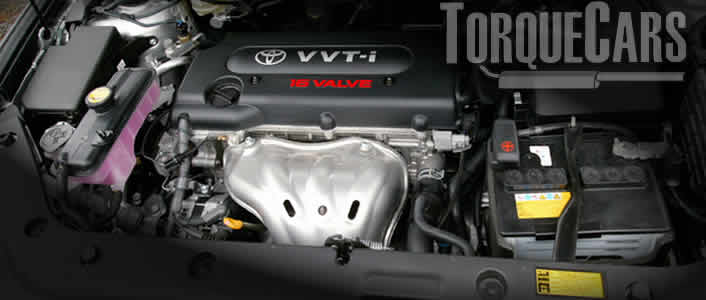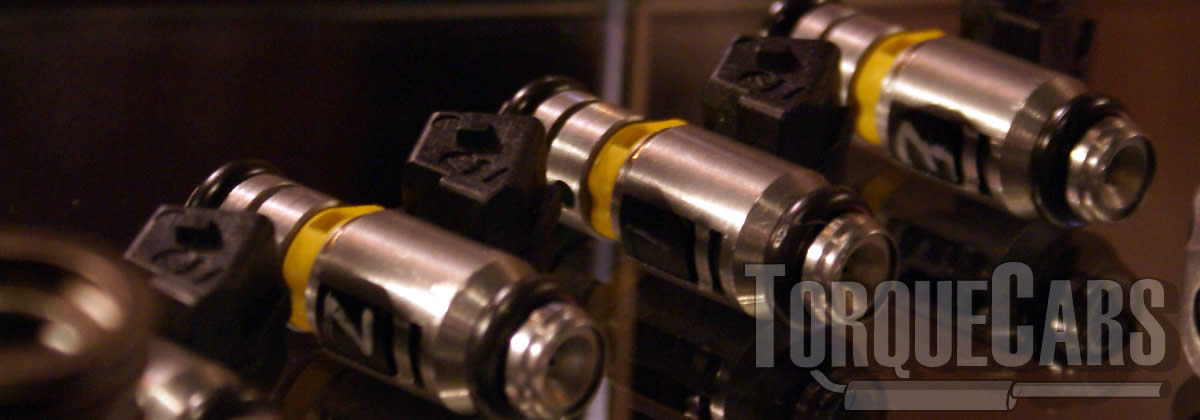Tuning the Toyota AZ
"Building the best modified Toyota AZ engine!"
Carref prides itself on providing the latest tips and guides to your modification project.
Our aim here is to detail the best approach to AZ tuning and summarise the premier modifications. Toyota AZ are good project engines and with carefully chosen sports mods like a remap, turbo improvements and camshafts you will really maximize your driving fun.
We rely on our visitors to pass on tips and tell us about their projects and what worked on their car, and this article is the culmination of the feedback we have received. First let us look at the history and specs of this engine and then consider which tuning modifications work best on it.
History of the Engine

1AZ-FE
- 145hp @6000 rpm 140 lbft @4000 rpm
1AZ-FSE
- 147hp 145 lbft of torque @4000 rpm
2AZ-FE
- 160 hp @5600 rpm 162 lbft @4000 rpm
- 158 hp - 170 hp Later versions were revised and had higher power outputs.
2AZ-FSE
- 161 hp @5800 rpm 170 lbft @3800
2AZ-FXE
- 211 hp @6000 rpm 190 lbft @4400rpm
Tuning the Toyota AZ and best AZ performance parts.
What are the most effective AZ upgrades
The best AZ tuning parts on an engine are usually the ones that give the biggest return for your cash.
We won't be swayed by popular AZ tuning parts, they need to be cost effective.
The cam profile plays a big part in the engines power output so cam upgrades make quite a large difference. The intake and exhaust durations will alter depending on the chosen cam profile, so large bhp gains are on offer for cam upgrades.

Fast road cams normally bump the torque across the rpm band, you may sacrifice a little low end torque but your high end rpm power will be higher.
Motorsport cams, bump the high end rpm power band but as a result the car will not idle smoothly and low end power nearly always suffers.
In a car driven daily must carefully try to match your engines power to your driving style.
I would be surprised if you have ever thought a AZ Competition cam is a pleasure to live with when driving around busy urban areas.

Each engine responds better to mild camshaft durations so set your engine up on a rolling road.
The map and injectors and fuel pump also will make differences on the power gains you'll hit.
Extending exhaust or intake durations can alter the power band and on most engines the exhaust and intake durations do not need to match, although most cams and tuners use matched pairs there are some advantages to extending the intake or exhaust durations.
Please watch our introduction Video tutorial to car tuning. Be sure to subscribe and support our new channel.
How to tune your car
- Improve the handling
Focus on Suspension improvements, such as coilovers and make sure the bushings are in good order and that the alignment is correct. Then focus on improving the brakes, with a big disk brake conversion kit and fast road brake pads.
- Remove restrictions
Focus on the intake and exhaust with filters being the common point of restriction in a tuned car. Intercoolers may also become restrictive on turbo engines so this may also need to be uprated.
- Burn more fuel & air
Increase the fuelling so it matches the air coming into the engine. The ratio is important so you need to improve the fuel pump and injectors, so the head mods, big valve conversions, fast road camshafts and forced induction upgrades extra supply of air is adequately met.
- Test and replace any weak parts
Weak areas are commonly the clutch, the turbocharger and pistons and crankshaft in a highly tuned engine. Makes sure these components will cope with your power aspirations.
- The Tune or Remap
A cars ECU controls the fuel, timing, spark and even the turbo in some cases, so to fully extract your gains you should remap the car last and this will fully release the power. Some cars are easy to map, and others require piggyback ECU's or aftermarket ECU's but this is the most vital step of your tuning project.
Modifying to Stage 1:
Drilled & smoothed airbox, Intake headers, Remaps/piggy back ECU, Panel air filters, Fast road camshaft, Sports exhaust manifold.
Modifying to Stage 2:
Fast road cam, high flow fuel injectors, induction kit, Sports catalyst & performance exhaust, fuel pump upgrades, Ported and polished head.
Modifying to Stage 3:
Adding or Upgrading forced induction (turbo/supercharger), Competition cam, Twin charging conversions, Engine balancing & blueprinting, Internal engine upgrades (head flowing porting/bigger valves), Crank and Piston upgrades to alter compression.
Remaps helps fully realize the full potential of all the tuning mods you've done to your AZ.
It will usually give around 30% more power on turbocharged vehicles and you can expect to see around 15% on NASP engines, but the end result will differs on the tuning mods you've fitted and the condition of your engine.
Getting air into your AZ is vital to any car tuning task.
Intake manifold transmit the air during the suck phase from the air filter and allow it to be fed into the engine cylinders with fuel for the squish phase.
Design and flow characteristics of the Intake manifold can make a substantial difference to to fuel mixing and power on the AZ.
Commonly we find the air intake manifolds are in desperate need of performance upgrades, although some makers provide reasonably well designed air intake manifolds.
Adding a AZ larger valve kit, getting port work and head flowing will also increase performance, & more importantly will afford you an improved performance increase on other modifications.
Which turbo upgrades are best?

NASP engines need quite a lot of work when you add a turbo, so we have a separate guide to help you take into account the pros and cons of going this route on your AZ
The more air you can get into an engine, the more fuel it can burn and uprating the induction with a turbocharger upgrade makes superb power gains.
There is a TRD supercharger kit available for the AZ engine and it works really well and was intended for the Scion application.
If your motor is turbocharged, tuning mods are more reliable and you'll see that turbo charged engines are built using more solid components.
However you'll find engines will have power limits
We recommend you find these limits and install better quality crank and pistons to cope with the power.
There are many people spending a fortune on turbocharger upgrades on the AZ only to watch the car explode soon after it's used in anger.
Big upgraded turbos often suffer low end lag, and little turbos spool up more quickly but won't have the peak end torque gains.
Over the last 20 years the range of turbo units is always moving on and we commonly find variable vane turbo units, where the vane profile is altered according to speed to lower lag and increase top end bhp and torque.
Twin scroll turbo units divert the exhaust flow into two channels and push these at differently designed vanes in the turbo charger. They also help the scavenging effect of the engine.
It is not unusual that there is a limitation in the air flow sensor (AFM/MAF/MAP) on the AZ when a lot more air is being pulled into the engine.
We see 4 bar air sensors coping with quite large power gains, whereas the OEM air sensor limited bhp and torque at a much lower level.
Adding a supercharger or additional turbo will make large bhp and torque gains, although harder to setup. We have this article covering twinchargers if you want to read more.
Fuelling
When you increase the power you will need to pay attention to to the fuel delivery.
More power needs more fuel.  Most tuners we speak with say to be generous with your injectors flow rate.
Most tuners we speak with say to be generous with your injectors flow rate.
As a rule of thumb add 20% capacity when buying an injector, this takes into account injector deterioration and provides a little spare capacity should the engine require more fuel.
We think this one is common sense, but you'll need to match your fuel injector to the type of fuel your car uses as well.
All the following flywheel power targets will assume an injector duty cycle of 80% and a base of 58psi of fuel pressure at idle.
4 Cylinder turbocharged engines
- 58 PSI 340cc/min 200hp
- 58 PSI 511cc/min 300hp
- 58 PSI 682cc/min 400hp
- 58 PSI 1022cc/min 600hp
5 Cylinder turbocharged engines
- 58 PSI 273cc/min 200hp
- 58 PSI 409cc/min 300hp
- 58 PSI 545cc/min 400hp
- 58 PSI 818cc/min 600hp
4 Cylinder NASP engines
- 58 PSI 285cc/min 200hp
- 58 PSI 426cc/min 300hp
- 58 PSI 568cc/min 400hp
- 58 PSI 853cc/min 600hp
4 Cylinder supercharged engines
- 58 PSI 312cc/min 200hp
- 58 PSI 468cc/min 300hp
- 58 PSI 625cc/min 400hp
- 58 PSI 937cc/min 600hp
Choosing the right performance exhaust
One of the most common mistakes and problems we see in tuning projects is usually down to the exhaust, or rather a poorly chosen exhaust for your engine.
Only look to uprate your exhaust if the existing exhaust is actually causing a restriction in flow.
On most factory exhausts you'll find the flow rate is good even on modest power gains, but when you start pushing up the power levels you will need to get a better flowing exhaust.
Sports exhausts increase the flow of gases through the engine.
But if the exhaust is too large, ie: it's over 2.5 inches bore, you will lose much of your flow rate and end up losing power and torque.
Common exhaust restrictions are in the filters installed, so adding a freer flowing performance alternative will help avoid this restriction.
Weak spots, Issues & problem areas on the AZ
The AZ engines are generally reliable and solid as long as they are regularly serviced and maintained.
Regular oil changes are vital on the AZ, especially when tuned and will help extend the life and reliability of the engine.
The 2AZ-FE engine in the 2007-2009 Camry may burn excessive oil
For more information on Tuning your AZ engine please join us in our friendly forum where you can discuss tuning options in more detail with our AZ owners. It would also be worth reading our unbiased tuning articles to get a full grasp of the benefits and drawbacks of each modification.
Please help us improve these tips by sending us your feedback in the comments box below.
We love to hear what our visitors have got up to and which tuning parts work best for them on each model of car. Comments are used to improve the accuracy of these AZ articles which are continually updated.
If you liked this page please share it with your friends, drop a link to it in your favourite forum or use the bookmarking options to save it to your social media profile.
Check out TorqueCars new YouTube channel, and see their awesome new content...
Feedback
Please use our forums if you wish to ask a tuning question, and please note we do not sell parts or services, we are just an online magazine.
Help us improve, leave a suggestion or tip
